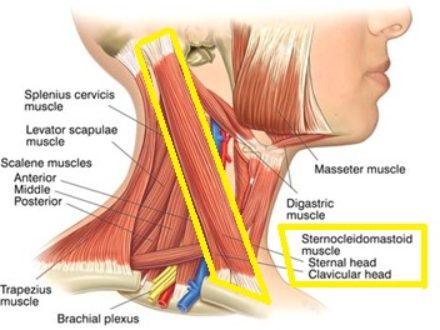
Infant Torticollis (Congenital Torticollis)
What is it?
Torticollis is Latin for “twisted neck”. In newborns, it is used to describe a condition where the baby’s neck is ‘stuck’ in one position, usually rotated with some side-bend, and isn’t able to move into the opposite position. It is similar to the adult presentation of “Wry Neck”, but has a different cause in newborns; it can be caused by positioning in the womb, or after a difficult childbirth. Experts say it normally isn’t painful for the baby, but rather more distressing for the parents. If it does occur, Torticollis generally presents in the first 3 months (but can occasionally occur later).
Unlike the adult “Wry Neck”, infant torticollis tends to be more muscular in origin. In particular, it seems to involve the Sternocleidomastoid (SCM) muscle that run from just behind the ear, down the neck to the sternum and collar bone. When this muscle gets tight, it pulls the head to the side and rotates it to the opposite side.
How will I know if my baby has it?
The most common sign of infant torticollis is a difference in your baby’s resting head position (as in, tilted and turned). Sometimes that can be difficult to tell in newborns, but often this can be very obvious. You may also notice a slight ‘bulging’ in the SCM muscle at rest.
Also, they may not being able to turn the head to both sides evenly. Your baby may not be able, or have great difficulty, to turn their head to see you. This can make it difficult for them to notice you approaching, or for them to see you moving around a room – and can make them very frustrated.
If they are breastfed, they may also have trouble feeding on one side.
They will also have the tell-tale sign at the back of their head – a flattening on the side they commonly lie on (Plagiocephaly). Don’t worry, this is fixable but can be worrying to see. As a baby’s skull is highly malleable, it will be able to return to normal shape with proper care.
This picture shows the front view of a baby with Torticollis:
This picture shows the flattening of the side of the head:
Picture courtesy of: http://www.fprmed.com/Pages/Ortho/Torticollis.html
What can be done to help, and how long will it take?
You may find that 1-2 appointments is all that it takes to clear up the Torticollis, and get your baby back to looking both directions and moving their head through full range. Your physiotherapist can provide you with practical information and exercises in order to help fix the Torticollis.
Information may include changes to feeding and/or carrying positions, cot placement and sleeping arrangements, and resting positions. Hands-on treatments may include gentle massage, gentle head movements and stretches, and exercises to perform at home.
Your physiotherapist will be able to provide you with specific interventions, according to your baby’s presentation and independent contributing factors.
Will it be an ongoing issue?
Once treated appropriately this should not become an ongoing issue, or lead to neck problems later on.
By age 1 to 1 ½ years old, most issues caused by torticollis should have completely settled, and full range of motion of the neck should have been completely restored. If your baby is still having problems and restriction after this time, you should definitely visit your GP or Paediatrician as there may be different interventions needed, such as surgery. Having said this, surgery is only performed as a last resort in a very limited number of presentations.
Masquerading issues
Before finishing, I feel it’s important to let you know that there are some other disorders that may appear similar to Congenital Torticollis, but are more significant. Klippel Feil Syndrome is one where the neck vertebrae are abnormally formed and/or fused (stuck together), and also causes problems with hearing and the kidneys. If you are concerned about this, or if your physiotherapist is concerned, you should visit your Paediatrician for a full assessment.
We’re hoping the above information will be helpful for you. If you are concerned at all, please contact your GP and/or Paediatrician, or if you would like to make an appointment with one of our physiotherapists, contact us at Therapia Physiotherapy and Pilates on (08) 8221 6436, or email us at info@therapia.com.au.
Book Appointment


